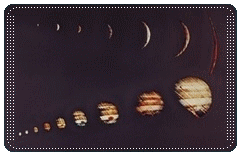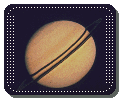
Pioneer 10 and 11 were first missions to Jupiter and Saturn. The Pioneer indeed were pathfinders to the coming Voyager missions (check at Voyager 1 and 2: Grand Tour of Gas Giants and Headed for the Stars) in terms of learening wheather a spacecraft could survive passing through the Asteroild Belt and Jupiter's strong radiation belts. As originally conceived, Pioneer 11 was intended as a backup to Pioneer 10 that was to launch 13 months earlier. NASAís Ames Research Center in Californiaís Silicon Valley designed and managed the two Pioneer. Pioneer 10 launched first on March 2, 1972, and its twin Pioneer 11 on April 5, 1973 and they carried 12 scientific instruments to study Jupiter and Saturn, their environments, and interplanetary space. As originally conceived, Pioneer 11 was intended as a backup to Pioneer 10. By the time the second spacecraft launched, the first had already safely traversed the asteroid belt and was on its way to the very first encounter with Jupiter. After Pioneer 10 successfully completed its observations of Jupiter, in May 1974 mission planners retargeted Pioneer 11 to use the giant planetís gravity to slingshot the spacecraft to encounter Saturn. By late July 1979, as both Voyagers had been launched, had performed their their fly-bys of Jupiter and were on their way to Saturn, NASA managers thus had to choose where to target Pioneer 11's flyby of Saturn to provide maximum support to the Voyagers: options included a more scientifically interesting but riskier passage through Saturn's inner rings or a less interesting pass through the outer rings. That was that second which was chosed because Voyager 2 was to pass outside the rings to ensure the proper gravity assist to send it on the following of its journey. Pioneer 10 launched on March, 2nd 1972 atop a three-stage Atlas/Centaur launcher and headed Jupiter. It became the fastest manmande probe, leaving Earth with a speed of 32,400 mph. Pioneer 10 passed at Moon 11 hours later and crossed Mars orbit in just 12 weeks. The craft was the first safely to cross the Asteroid Belt on Feb. 15, 1973 -which until then was feared impenetrable and thus a spectacular achievement of its time- and became accelerated by Jupiter's gravity, bringing its speed to 82,000 mph. It passed within 5.5 million miles of a unnamed 0.5-mile diameter asteroid on Aug. 2 and passed to 15-mile wide asteroid 307 Nike on Dec. 2, 1972. It took seven months to Pioneer 10 to cross the belt. By Dec. 1, 1973 the spacecraft was returning images of the planet exceeding the best pictures from Earth. Jupiter was reached on December, 3rd 1973 as the craft passed 81,000 miles atop planet's clouds. Science at Jupiter yielded Jupiter and its moons' first close-up images and measurements and location of Jupiter's magnetosphere, a appreciation of its intense radiation environment, a chart of its radiation belts, atmosphere, and interior. During the encounter, which ended Jan. 2, 1974, Pioneer 10 returned about 500 images of the planet and its satellites. Pioneer 10 also provided new information about the conditions of interplanetary space in the outer solar system, including the solar wind and cosmic radiation. The probe then used Jupiter's gravitational slingshot to leave the solar system, turning the first human-made object to accomplish that deed! The 571-pound spacecraft carried 11 instruments, a helium vector magnetometer to measure Jupiterís magnetic field; a quadrispherical plasma analyzer, a charged particle instrument, a cosmic ray telescope, a Geiger tube telescope, and a trapped radiation detector to measure the solar wind and radiation levels; meteoroid detectors and an asteroid/meteoroid detector to record interplanetary dust particles; an ultraviolet photometer to determine the quantities of hydrogen and helium in space and on Jupiter; an imaging photopolarimeter to return images of the planet; and an infrared radiometer for temperature measurements. Pioneer 10 -- like its 11 twin -- used plutonium-238 in two radioisotope thermal generators (RTG) to supply power to its systems and instruments, since at the giant planetís distance from the Sun, capturing enough solar energy would have required solar arrays prohibitively large. It passed the orbit of Neptune by June 1983, still operating normally and returning valuable information as NASA, through the Deep Space Network, maintained regular contact with Pioneer 10 until in March 1997 -- the time of the mission official end -- and intermittent contact thereafter. The power generated by its RTGís had diminished and the spacecraft sent its last signal to Earth on Jan. 23, 2003, nearly 31 years after its launch, when it was 7.6 billion miles from Earth. That last signal took 11 hours and 20 minutes to reach Earth
 | Jupiter seen of ever-increasing size by Pioneer 10 (bottom) as, after closest approach images gradually build up into a very distorted, decreasing in size, crescent-shaped Jupiter (top). picture courtesy NASA |
The Atlas vehicle had a total thrust of 411,353 pounds, consisting of two 174,841-pound-thrust booster engines; one 60,317-pound thrust sustainer engine, and two vernier engines, each developing 676 pounds thrust. Propellants were liquid oxygen and RP1.The Centaur second stage had two engines with a total thrust of 29,200 pounds. This stage carried insulation panels which were jettisoned just before the vehicle left the Earth's atmosphere and were used to prevent heat or air friction from causing boil-off of liquid hydrogen on the pad and during the flight through the atmosphere. The propellants were liquid hydrogen and liquid oxygen. For the Pioneer missions, a solid-fueled TE364-4 third stage developed approximately 15,000 pounds of thrust. This stage also spun the spacecraft up to 60 rpm
Pioneer 11 launched on April, 5th 1973 using the same launcher than Pioneer 10 and reached Jupiter passing 26,725 miles atop clouds on December, 2nd 1974. Pioneer 11 was intended as a backup for the dangerous mission. A single additional instrument, a Flux-Gate Magnetometer, was the only difference between Pioneer 11 and the craft that had already become. This close approach was used as a swing-by acceleration: Pioneer 11 reached the fantastic speed of 108,000 mph projecting it to Saturn, it reached 1.5 billion miles further on September, 1st 1979. At Jupiter craft obtained close-up pictures, made first observations of polar regions, and assessed mass of Callisto, a Jupiter's moon. At Saturn -which the craft was the first probe ever to approach- flying at 13,000 miles above the planet, Pioneer 11 took first photographs of the ringed planet. Two moons and an additional ring were spotted as magnetosphere was charted and the liquid hydrogen nature of the atmosphere recognized. As its twin, Pioneer 11 continued its work until solar system limits. Mission officially ended on September, 30th 1995. No communication was received since from the spacecraft. As far as Saturn was concerned, the Pioneer 11 was retargeted mid-flight, by May 1974, to include another planetary encounter. The science team at NASA's Ames Research Center in California decided not simply to duplicate Pioneer 10ís mission, but to build upon it, directing the small craft to use Jupiterís massive gravitational pull as a slingshot to propel the craft at a significantly increased velocity to Saturn, to be met by 1979. Pioneer 11 successfully had completed its crossing of the Asteroid Belt in turn in April 1974. After some pressure from the next Voyager mission team at NASAís Jet Propulsion Laboratory in Pasadena, Calif., who wanted Pioneer to test the path that Voyager would follow several years later -- both Voyager had been launched and had passed Jupiter already -- a decision was made to travel much closer to Jupiter than Pioneer 10 (at the time, the Voyager missions had been launched a full two years before Pioneer 11 reached Saturn and were already heading towards Jupiter). This more risky path was opposed by some of the Pioneer team, but on December 2, 1974, Pioneer 11 passed only 42,000 km above Jupiterís cloud tops. Pioneer 11ís route took the spacecraft over the poles of Jupiter to avoid the intense radiation belts around the equator. This allowed the first mapping of the planetís polar regions and sent the craft hurtling through space at a record speed of 107,400 miles per hour. Because of Pioneer 11ís ambiguous status as a combination of science and engineering demonstration mission, a heated debate broke out in the NASA community about what route it would take past Saturn. Also about Saturn's rings which were ill-known at the time, a discussion unfolded about whether the Pioneer should travel through the inner, or the outer ring -in any case it would help for the gravitational assist at Saturn by one of the Voyagers. Ultimately, it was decided by NASA Headquarters that Voyager 2ís safe passage to Uranus and Neptune would yield more scientific discovery than Pioneerís path through the inner rings of Saturn and Pioneer was deciced to pass through the outer rings at the dismay from the Pioneer team. Sep. 1, 1979, Pioneer 11 passed within 13,000 miles of Saturnís cloud tops at a velocity of 71,000 miles per hour. During the encounter, it sent back data on the planet, its rings, and its satellites, including 440 images
 |  | Jupiter seen by Pioneer 10 (left); Saturn seen by Pioneer 11 (right). pictures courtesy NASA, Ames Research Center |
The Pioneer 11 after Saturn which it had reach with course corrections in May 1976 and July 1978, sailed on a trajectory that took it out of the solar system. On February 23, 1990, it passed the orbit of the outermost planet and began its interstellar mission. The Pioneer 10 and 11 were part of a Pioneer spacecraft series -two of them Venus bound in 1978. Pioneer 10 and 11 were managed for NASA by the Ames Research Center, Mountain View, Calif. Probes were usual interplanetary probes, 9.5 ft wide, with a high-gain antenna, spin-stabilized, six Hydrazine thrusters, electrically powered by radioisotope generators (RTG), and featuring three instruments-carrying booms. As mission designers were conscious these two spacecraft were going to be first manmade objects to leave solar system, they bolted unto the probes a plaque carrying a graphic message. Plaque was designed by Carl Sagan, Frank Drake and Linda Salzman Sagan. An illustration of the hyperfine transition of neutral atomic hydrogen is shown along with two human beings at scale relative to a sketch of the craft and a location of Earth and of the solar system. These data are thought to be decipherable by any advanced civilization knowing hydrogen. Pioneer 10 is now 7.8 billion miles avay and coasting in the dark heading in the direction of Aldebaran, main star to constellation of Taurus, the Bull. It will reach there about 2 million years from now, at a speed of 27,500 mph. Pioneer 11 is heading to Aquila, the Eagle, it will reach in about 4 million years. The final signal from the Pioneer 11 was received on Nov. 24, 1995, when it was more than 4 billion miles from Earth
Website Manager: G. Guichard, site 'Amateur Astronomy,' http://stars5.6te.net. Page Editor: G. Guichard. last edited: 12/5/2018. contact us at ggwebsites@outlook.com